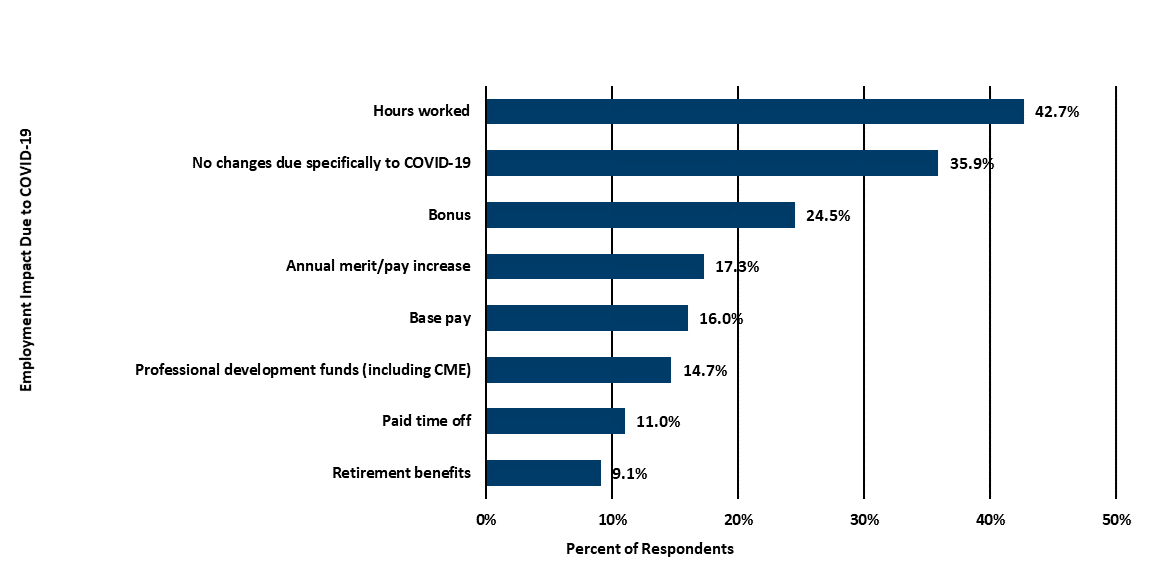How COVID-19 Impacted PA Salaries
2021 AAPA Salary Report Sheds Light on Compensation and Benefits During Pandemic
July 30, 2021
By AAPA Research Department
The year 2020 brought with it a global pandemic and a tremendous strain on the healthcare system in the United States, including the PA profession. As part of the 2021 AAPA Salary Survey, now available in PDF format on aapa.org, AAPA’s Research Department collected data to understand the impact of COVID not only on the PA workforce, but on compensation as well as practice changes.
1. Almost two in three PAs experienced at least one employment impact because of COVID-19

[Get the full scoop on PA salaries as an AAPA member – join or renew today]
2. Median profession-wide compensation decreased for the first time in years
COVID-19 impacted the wallets and bank accounts of many PAs. Overall, among full-time PAs, the median compensation across all compensation types was $110,000 (with annualized base wage), down from $111,000 in 2019. Median hourly wage decreased to $61.00 from $62.73 and productivity pay was $144,000, down from $145,000 the prior year. Bonuses took a hit, as well. Among full-time PAs, about half (48.7%, down from 50.1% the previous year) received a bonus, and for those who did, the median bonus was also less than the previous year: $4,500, down from $5,500. Of those who are paid an annual salary in 2020, median annual base salary was $110,000, steady from 2019.
3. PAs experienced both increases and decreases in compensation due to COVID-19
Among full-time respondents who said their base pay was impacted as a result of COVID-19 and provided their base salary, more than one in three respondents (35.4%) had a decrease in base salary (from a median of $115,000 in 2019 to a median $103,000 in 2020) and three in 10 (30.0%) had a decrease in hourly wage (from a median of $70.80 in 2019 to a median $60.00 in 2020). More than three in 10 salaried PA respondents (31.5%) and more than one in three respondents (37.4%) paid an hourly wage saw no change in their annual pay, perhaps due to other changes in hours worked that masked an increase or decrease. Finally, of the respondents who said their base pay was impacted due to COVID-19, almost one in three salaried PAs (33.1%), as well as hourly PAs (32.6%), had an increase in pay (from a median of $104,500 in 2019 to a median $115,000 in 2020 for salaried PAs, and from a median of $58.00 in 2019 to a median $65.00 in 2020).
It is important to note that some PAs reported their hours or compensation were impacted as a result of COVID-19, but there may not have been a measurable change from the number provided for 2019. This could be a result of multiple factors, including that there were ultimately increases or decreases for other reasons as well, masking any change that occurred as a result of COVID.
Author is Timothy C. McCall, PhD, former associate director of surveys & analysis at AAPA. Contact the AAPA Research Department at [email protected].
Author’s note: More in-depth information is available in the executive summary of the 2021 AAPA Salary Report.
More Resources
2021 AAPA Salary Report
Thank you for reading AAPA’s News Central
You have 2 articles left this month. Create a free account to read more stories, or become a member for more access to exclusive benefits! Already have an account? Log in.



